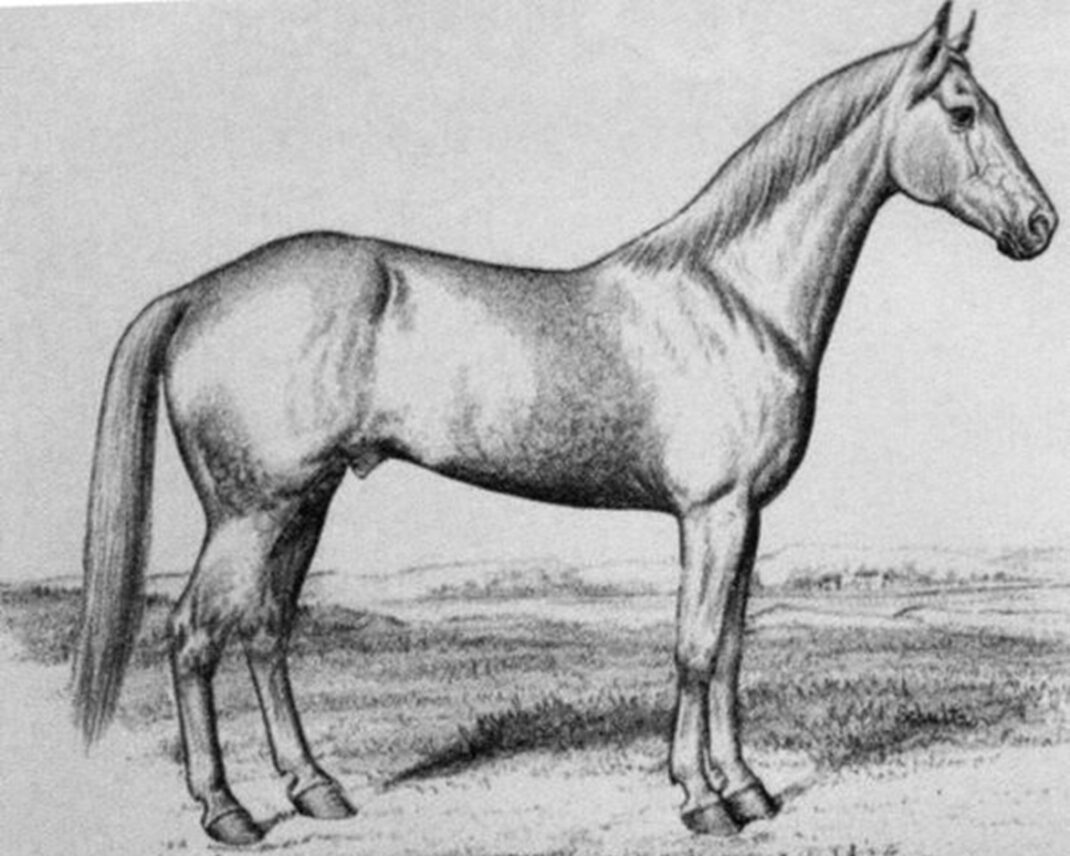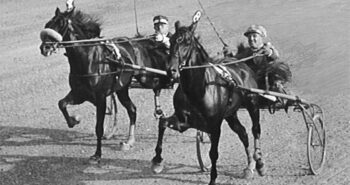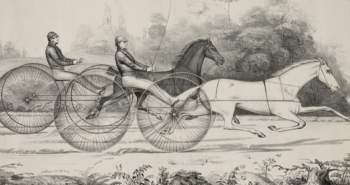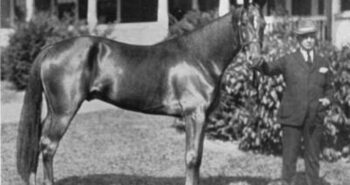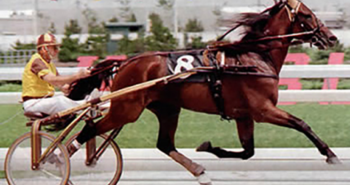Grey trotters have always caught the attention of the public, Greyhound naturally being a big reason. Of the thousands of stallions at stud before 1900, very few were successful sires of speed – and almost no grey ones. One exception, though, was Pilot Medium who sired Peter the Great. Pilot Medium’s grey coat is inherited from his damsire, Pilot Jr, who was a famous horse in his time and widely acknowledged as the best horse in “the Pilot family.”
The origins of the Pilot line trace to Quebec. Pilot was also referred to as “Pacing Pilot”, “Canadian Pilot”, “Old Pilot” or just Pilot. He was described as a coal black horse with a rather heavy and long body with a heavy mane and tail and of ugly temper. He was said to have been “compactly-built and a very muscular horse, something less than 15 hands (152 cms) in height.” Joseph Battell spent many hours trying to track down Pilot’s origins and came up with following, taken from John Hervey’s book The American Trotter: “Bred by Louis Dansereau in the province of Quebec and foaled 1823. Sire unknown; dam Jeanne d’Arc, by Voyageur. The black stallion was a fast pacer but reputedly so vicious that the owner would not even go in the stall with him. While in Montreal in 1830, the peddler Elias Rockwell bought him for $150. Rockwell, from Stafford Springs, CT and later settled in Norwich, NY, travelled all over and did a little horse trading on the side. Rockwell had put a bridle and saddle on Pilot and after riding him he bought the black stallion.” The latter historical piece of information suggest that maybe the claims about his temper may have been a bit exaggerated.
Pilot was wintered at Stafford Springs in Connecticut. Rockwell sold a half interest to John Dean and when the roads were usable in the spring the pair started off with a wagon full of yankee notions. Together with an unknown horse owned by Dean, Pilot was tied to the tail gate of the wagon. They worked westward and southward, trading and racing, until they reached New Orleans at which point Dean’s horse is said to have died. In (or around) New Orleans, Rockwell worked Pilot in 2:26 (1.30,7) and then sold him to Major O Dubois for $1,000. Back then this amount for a horse was unheard of but Dubois planned to recuperate the money, and more, by using Pilot in a series of match races. But rumors of the fast trial had leaked out and as a result nobody was willing to race against him for money. Instead he was sold for cost to D Henisohn of Louisville, KY and the horse remained there at stud until just prior to his death in 1855.
According to official court records from Tolland County, CT, there was a case on the docket under the title of “Dean vs Rockwell” in December 1832. The information is limited but the case was to recover $500, one half of the amount for which Rockwell sold a black pacing stallion. The case was tried in William Kill’s Hotel in Stafford Springs and was decided in favor of Dean. In this writ the horse was represented as being about seven years old. if “seven years old” refers to his age at the purchase time it would make the foaling year 1823, just as Joseph Battell claimed but if it refers to his age in 1832 he would have been born in 1825. The latter seems corroborated by an 1887 article in the Middlebury Register, see below, which states that “Major Dubois induced the peddler to part with Pilot about the date above mentioned, his age at that time represented as six years.”
Pedigree uncertainty
Pilot was a pacer and most of his foals were pacers. An exception was Pilot Jr, foaled in 1844, who preferred the diagonal gait. Just as there is uncertainty about Pilot Jr’s paternal heritage, there are also questions surrounding his maternal pedigree. What is certain, is that Pilot Jr is out of Nancy Pope, a daughter of Nancy Taylor. Nancy Taylor was an elegant mare and a fast pacer who had the appearance of fine breeding, though nothing could be definitely established regarding her lineage. Different articles provide different information about the rest of the pedigree and historical facts. In an article in Hoof Beats February 1955, Ken McCarr claims that “in 1831, owner Pope bred the mare to a a farm stallion that was standing about four miles away from his farm. The result was a gray filly that was larger and coarser than her dam and was afterward called Nancy Pope. She lacked the fine finish of her dam and took more of the characteristics of her draft horse sire. An attempt was made to develop Nancy Pope into a saddle mare but at best she remained a good draft mare. In 1843 she was taken to Pilot and while carrying the foal she was sold to John T Gray. Pilot Jr was foaled his property.”
A lengthy article in the Middlebury Register published on Mar 25, 1887 gives a somewhat different account: “The dam of Pilot Jr was a good-sized gray mare, bred by WH Pope of Kentucky, and finally sold to RA Alexander of Woodburn Farm, to whom she was represented as a daughter of Havoc, by Sir Charles, by Sir Archy. Mr JH Wallace contends, however, that Nancy Pope was by a large, coarse farm horse of unknown breeding, and bases this claim upon the statement of Mr Edmund Pearce, a gentleman in good standing who lived in the neighborhood where the dam of Pilot Jr was raised, but depends wholly upon memory for his version of the events which occurred something like half a century ago. A board of censors who investigated the matter also agreed with Mr Wallace, and the mare is now registered as of unknown breeding.”
Disproving Wallace’s claim
Ken McCarr adds that “After Pilot Jr started to do well, an attempt was made by Alexander to get the horse a fine pedigree and it was claimed that Nancy Pope was by a thoroughbred stallion called Havoc. The only Havoc in the neighborhood of Nancy Taylor had been poisoned and died four years before Nancy Pope came into the world.” McCarr’s claims are fully based on Wallace’s conclusions. But diving deeper into the historical facts and accounts, it seems painfully obvious that Wallace based his claims on ill-founded personal convictions, inaccuracies and an incorrect factual basis – something which he did on several occasions. These claims were examined thoroughly in the 1905 book American trotter; a treatise on his origin, history and development book and is so thorough and useful that, though lengthy, needs to be quoted in its entirety:
“The dam of Pilot Jr, was known as Nancy Pope. Her breeding was the subject of considerable controversy several years ago, as some of our readers doubtless remember, and Mr Wallace finally persuaded some of the Board of Censors to believe that her sire was a large bay cart horse of unknown breeding. Mr WM Pope, the breeder of Nancy Pope, so far as we have been able to learn, enjoyed a good reputation for veracity. No one who knew him has ever gone on record as accusing him of dishonesty or untruthfulness. He always claimed while living that Nancy Pope was by a horse called Havoc, owned by Mr Peter Funk. The statement of the breeder of an animal is the strongest evidence that can be presented of that animal’s paternity. The fact that Nancy Pope was by a running-bred horse called Havoc was never questioned until Mr JH Wallace had become thoroughly imbued with the idea that trotting speed could not come from an animal whose sire or dam was from thoroughbred stock.
The pedigree of Nancy Pope as it now appears in Wallace’s American Trotting Register, rests solely upon the statements of Mr Edmund Pearce, who was a mere youth at the time that Mr Peter Funk owned the stallion Havoc, by Sir Charles. The pedigree of Nancy Pope was not assailed and investigated by Wallace until after the death of Mr Pope, her breeder, and Mr Funk, the owner of her sire. When Wallace registered Pilot Jr, in Vol. 1 of the American Trotting Register, he gave his pedigree as follows: “Got by old Pilot, a Canadian pacer ; dam Nancy Pope by Havoc 1118; second dam by Nancy Taylor by Alfred 53.” Mr Wallace evidently did not know at that time that there were two stallions called Havoc that were sired by Sir Charles, but took it for granted that the Havoc referred to must be the one registered by him in his thoroughbred Stud Book under No. 1118.
Mr Wallace learned that Nancy Pope, the dam of Pilot Jr, was foaled not later than 1825. He was informed by Attorney General Speed that Nancy Taylor, the dam of Nancy Pope, became the property of his father in 1824. Attorney General Speed fixed upon this date, 1824, from memory, but it was afterwards discovered that he had made a mistake of nine years, and that it was not till 1833 that Nancy Taylor became the property of his father. Mr Wallace found upon referring to the registration of Havoc 1118 that this son of Sir Charles was not foaled until 1826, which proved conclusively that as Nancy Pope was foaled as early as 1825, she could not possibly be by Havoc 1118. He soon learned, however, that Havoc 1118 had never been claimed as the sire of Nancy Pope, but that her sire was the Havoc by Sir Charles, which was owned by Mr Peter Funk. Continuing his investigations Mr Wallace learned that Funk’s Havoc, by Sir Charles, died about 1827 or 1828. He then found Mr Edmund Pearce, a man of unquestioned veracity, who when a boy lived in the neighborhood of Mr Funk. Some fifty years had elapsed between the foaling of Nancy Pope and the time that Mr Pearce made his statements in regard to Havoc, and he relied solely upon his memory in the matter. He stated that Nancy Pope was not foaled until 1831 or 1832, and was got by a large bay cart horse called Havoc, that was owned by Mr Funk who owned the Havoc that died about 1828 and was got by Sir Charles, a son of Sir Archy.
All that Mr Pearce claimed to know about the matter was that he heard Mr Frye, who was Mr Pope’s overseer, say that Nancy Pope was got by a fine draught horse that stood over on the Shelbyville Pike, about four miles from Mr Pope’s residence. Mr Pearce also stated positively that Mr Funk did have a bay horse when he (Pearce) was a boy and he was said to be a blood horse, but he knew he was not the sire of Nancy Pope.
Now, as already remarked, something like fifty years had elapsed between the time that Nancy Pope was foaled, and that when Mr Pearce made the above statement. He relied solely upon his memory. The matter was one which could not have been of the slightest interest to him at the time it occurred, and yet he does not hesitate to state positively that Naney Pope was not foaled until 1831 or 1832. It was a very remarkable assertion, and it is not surprising that though an upright man, who believed he was correct, he made a mistake in the date as other honest men have done before. That such was the case has been proven beyond question, and that Nancy Pope was foaled as early as 1825 there is not a shadow of doubt.
Mrs Funk, widow of the man who owned Havoc, and by events which occurred about the time that the horse died, fixes the date of Havoc’s death as 1827. She stated that Havoc was a chestnut in color. John Funk, a son of the owner of Havoc, remembered the horse well. He was as old as Mr Pearce, and a more competent witness because his opportunity of knowing the facts were superior to those of Mr Pearce. In a letter to J.H Wallace, this John Funk describes the horse as follows: “Havoc was undoubtedly a thoroughbred, on one side closely descended from Diomed, and on the other side Buzzard. My father did not breed him, but purchased him.” Mr John Funk also stated that Havoc was a chestnut in color. This is the horse that Mr Wallace’s witness, Edmond Pearce, who probably never saw him in his life, described as a bay draught horse, for Mr Funk never owned but one stallion called Havoc. Mr Pearce stated from memory that Mr Frye, Mr Pope’s overseer, said the horse stood about four miles from Mr Pope’s place at Louisville. The actual distance was eight miles. The matter of distance was of very small importance, but it shows that the memory of Mr Pearce was so much at fault as to cast doubt on all his other statements.
There was another man whose opportunities for knowing and remembering the facts in regard to this matter were better than those of Mr Pearce. This was Mr Charles Anderson, who was a little older than Mr Pearce, and who at the time of Havoc, lived within one and one-half miles of Mr Funk. Mr Anderson was much more intimate with the Funk family and Mr Funk’s horses than was Mr Pearce. The controversy in regard to the breeding of Nancy Pope and the statements in regard to her sire, Funk’s Havoc, were brought to the notice of Mr Anderson, and he was urged by parties who were anxious to know the truth, to state what he knew of the matter. This he did in a letter to Mr Wallace. The letter was published in Wallace’s Monthly, but not till after it had been decided upon the strength of Mr Pearce’s statements that the sire of Nancy Pope, dam of Pilot Jr, was a large bay cart horse. A part of Mr Anderson’s letter was as follows:
“As far as I am concerned, the reminiscences of my friends, Speed, Pearce and Gray, as well as your ‘pet theory’ of breeding, must alike go down before my confidence in the simple honesty of Major Funk in these transactions. This is my main motive to this reply; to respond to a call from my especial friend, Andrew Steele, and to correct the misunderstandings of my former and forgotten statements, are my lesser purposes, I know very little of this controversy. As it seems to me, it is only the accidental status of your present discussion which gives the least significance or interest to my knowledge.
Our neighbor, Major Funk, one and one-half miles off, in or about the year 1822, became infected with a violent passion, if not mania, for racing and for breeding race horses. He was alone in his taste or enterprise, of all the citizens of Jefferson County of that time. He bought some stock, laid out a race track, built stables, etc, and gathered such a crowd of stallions, mares, keepers, trainers, riders and other attendant persons and things, that his new enterprise became, with different minds of the neighborhood, a cause of surprise, regret and derision. I do not know or believe that any other man in the county had a thoroughbred of either sex. I am sure Mr Funk then had (as far as he knew) no other sort for breeding. These appear for me to be important items in this question as it stands.
Amongst these stallions in training, or standing, there were Stockholder, Archer (also by Sir Archy), Sea Serpent, by Shylock (I believe), Conqueror, Whip Tiger, with other less distinguished juveniles, and at a somewhat later date perhaps. Havoc, the horse in dispute. I could, if I were not ‘to inquire too curiously,’ give you also the names of sundry mares, fillies and colts then assembled there.
I remember Havoc very distinctly more so than if I had seen him last year, he was not a bay, but a chestnut (or “sorrel” as the color was then called), nor was he as dark or dull colored as Wagner was, but a bright yellowish sorrel. As to size, he was of the medium size and shape of thoroughbreds. I think about of such proportions as Sir Archy or Sir Charles may have been, guessing by their pictures in the Turf Register.
There never was any large bay horse called Havoc owned by Peter Funk. Be assured of this fact. On this point I must stand up for my own superiority “of opportunities” to your other “Beargrass boys.” Major Funk’s race course was entirely out of their beat. The Speed boys were good, and did not habituate such places. And although Ned Pearce and John Gray (like the writer) were certainly “fast” enough for any deviltry of that sort, yet I have no idea that either of them ever saw Stockholder, or Havoc (any Havoc) in their lives. What then could either of them know of his size or color?
He was reputed to be by Sir Charles. As I have almost ever since kept my knowledge of pedigrees refreshed by reading in The American Turf Register, etc., I am now unable to say whether any part of his remaining pedigree (by Sir Alfred Virgo, by imported Teazle, Castianira, etc.), to be a matter of memory, derived from the reputation of the neighborhood, or from subsequent studies. But I think the reputed pedigree then was Havoc, by Sir Charles; dam, by Sir Alfred. I am quite sure, though, it was by Havoc, by Sir Charles. Remembering now that I never in my life heard one word in disparagement of the integrity or honor of Major Funk (unless the deplorings of the “unco righteous” of this race horse business may be construed into such impeachment), do you not see in what a light your present proposition must appear?
We are required to believe that such a man would bring from “a trip to Philadelphia” a farm horse of unknown breeding, “a large bay horse,” and palm him off as a thoroughbred “Havoc, by Sir Charles, Sir Alfred,” and in a county, too, in which the forged pedigree (if believed) would not have added one cent to his custom. If, therefore, Mr Pope did send Nancy Taylor to Mr Funk’s Havoc (as witnesses affirm) he must certainly have sent her to the chestnut horse Havoc, by Sir Charles, Sir Alfred. Nor will it be pretended that, at that time, when no portion of this interest (which now lies in the pedigree of Pilot Jr) had attached to this simple transaction, any of these neighbors’ boys were likely to have known any facts to outweigh these truths and probabilities.
Of the actual breeding of Nancy Pope (the pedigree in question), I know nothing. All I do know or surmise of its connection is as follows: My eldest living brother, Lars Anderson, then, through my father’s death, “in loco parentis,” to me, in June, 1828, married Miss Anne Pope, the only daughter of Mr WM Pope, who owned these mares. Some time previously I had become intimate with his boys, though I had known the family all my life. The family had been close friends since the period when Louisville was St Nelson. And, from the time of that marriage, as long as his family occupied the farm, I was as much “at home” there as one of his own children almost. Now at the period of the wedding (certainly a marked occasion and date to me), I well remember a grey filly there, out of Nancy Taylor. She was two or three years old. She was a dark but bluish grey. I doubt if I am as good a judge of a horse as my friend and kinsman, Edmund Pearce. Still, although I remember her as larger than her dam, I could never consider her as “coarse” in the sense of a likeness to “large farm horses” nor as being out of the proportions of thoroughbreds. I certainly did not and do not suppose her to have been thoroughbred. (In your advertisement of Almont she is “said to be strictly thoroughbred”). I only mean to say that I have seen a great many true thoroughbreds, especially in England, which were both larger and coarser than this grey filly of 1828.
But, ‘Mr Pearce is positive in his assertion that about 1831 Mr Pope bred Nancy Taylor to a farm stallion, and the produce was a filly larger and coarser than her dam, that afterwards was called Nancy Pope, and became the dam of Pilot Jr.’ Now, if there be no mistake here, the question is settled without appeal. But is there no mistake? I repeat that I am sure Mr Pope had a grey filly out of Nancy Taylor in 1828, which he presented to my brother Lars, and that he sent her for awhile to pasture at Soldier’s Retreat, where I was living (the only son) with my mother. And, furthermore, I cannot recollect any other grey filly out of Nancy Taylor or any other dam on that place, until it was rented out to Judge Mclnley of Alabama, and Mr Pope moved to Louisville. Does anyone remember a second? What does Mr Robert Pope, the only remaining son of Mr Pope (and of 1814, too), remember of there being two grey fillies? or Mr Speed, Pearce or Gray (who, by the way, was as often on the farm as E Pearce)?
My own recollection is, of course, not conclusive. But, I submit, is it not of a nature as weighty as Mr Pearce’s recollection of the date 1831) when a neighbor sent a mare to a common stallion, an event which did not contain the slightest import or interest for almost a quarter of a century? The case of Attorney-General Speed is an example of the native unreliability of such testimony. He “recollected” the year 1824-5 as the time when “Mr Pope presented Nancy Taylor to his father.” It turns out to have been in 1833, nine years later. (I have reasons to doubt whether it was not still a year later, 1834).
Now, this affair of the ownership of a pet mare, by Judge Speed, must have been one of far more interest to one of his sons than that of the time when a neighbor sent a mare to a common farm horse could possibly be to the other. And yet the attorney-general of the United States (and, let me add, one of the ablest lawyers and best men in the State) forgets the date of that transaction by a gap of nine or ten years. I insist, then, that it is not only no impeachment of Mr Pearce, not the least, to express a doubt of his date, but that his recollection (if there were no counter memories) is per se of very slight historic weight.
So as the testimony stands then (counting in it, of course, my own recollection) I must believe that after 1828 Nancy Taylor had no grey filly; that this filly must certainly have been begotten by a horse standing some four miles off, between 1824 and 1828; that Major Funk, then and there, kept a stallion. Havoc by name, a chestnut in color, and claimed and reputed to be by Sir Charles — Sir Alfred — and that Mr Funk neither had nor stood any large bay or other farm horse, until long after these dates, when, abandoning his thoroughbred mania, he did buy and stand such a horse, named, I think, Pennsylvania Farmer.
All this, sir, may not prove that Pilot Jr’s grandsire was Sir Charles. Indeed, it does not prove it, but it surely diminishes the probabilities of the contrary supposition to a very attenuated quantity. And, if the question must be reduced to a single point between that pedigree on the one hand and the allegations of Nancy Pope’s sire being a “large, bay horse” or a “common farm horse, called Havoc” or any other sort of a horse than that claimed by Peter Funk, on the other hand; then, indeed, in my judgment, it is a certainty that the former pedigree is established.
There is no doubt that this grey filly that was presented by her breeder, Mr Pope, to Lars Anderson in 1828, and was then two or three years old, was afterwards known as Nancy Pope, and was the dam of Pilot Jr. The latter is registered in the Breeders’ Trotting Stud Book, published in 1881, and his pedigree which is there given as follows is undoubtedly correct: “Pilot Jr, gr. h, foaled 1844, bred by Lugerean Gray, and foaled the property of John T Gray, Graybolt, Jefferson Co, Ky, got by old pacing Pilot, a horse of unknown blood that, it is said, was brought from Canada; dam Nancy Pope by Havoc, son of Sir Charles (Havoc’s dam by Chanticleer; 2nd dam Camilla by Symme’s Wildair, etc.); 2nd dam Nancy Taylor by Craig’s Alfred, son of imported Medley.
Sold when four years old to D Heinsohn, Louisville, Ky, and soon afterward to R A Alexander, Spring Station, Ky. Died April 14, 1865, at Montgomery, Kane Co, Ill., where he had been sent by Mr Alexander along with nearly all his valuable trotting stock, to escape danger from guerrillas.”
There is no doubt that had Mr Anderson been called as a witness in the case and his statements been submitted to the Board of Censors, along with those of Mr Pearce, that the dam of Pilot Jr, would now appear in the American Trotting Register as Nancy Pope by Funk’s Havoc, a son of Sir Charles, the same as given in the Breeders’ Trotting Stud Book, a work in which Mr AJ Alexander, the proprietor of Woodburn Farm, and Mr Lucas Brodhead, the superintendent of that establishment, were somewhat interested. They were both on the committee on rules for registration by which that register was governed.”
(Given the amount of information included it is hopefully understandable why such a large quotation was necessary. Given all this information the claims by Wallace, and also repeated by McCarr in Hoof Beats, should carry little weight.)
Stubborn and capricious
Not much information exists about Pilot Jr himself or his life at stud. Dwight Akers’ book Drivers Up gives some clue about his personality, though, as it says that “as a family the Pilot Jrs were stubborn and capricious, hard to train and hard to manage, but they had speed and unconquerable courage”. Even though it refers to the “family”, it seems fairly is safe to assume that Pilot Jr himself also must have been “stubborn and capricious, hard to train and hard to manage” but with “speed and unconquerable courage.”
At the age of four Pilot Jr was sold to D Heinsohn of Louisville and then in 1857 to Robert A Alexander, and the grey stallion then stood stud at Alexander’s Woodburn Farm 15 miles from Lexington. During the Civil War, Confederate guerrillas raided the farm and stole several of the best horses. As they were pursued and hunted down immediately, most horses were recovered although a few, including Alexander’s Abdallah, tragically died. Pilot Jr, on the other hand, was thankfully spared.
A legacy through his daughters
In 1865, Alexander advertised most of his horses, both thoroughbreds and standardbreds (or “trotters”, as the breed was not defined yet), but shortly after seems to have had a change of heart as he instead decided to ship his horses to a farm outside of Montgomery, Illinois. A total of 43 horses were shipped by rail to Montgomery in February 1865. Just two months later, in April 1865, Pilot Jr died of apoplexy at the age of 21. He is buried where the present day Austin Park is located. Within 2 years the entire operation was moved back to Kentucky, and Woodburn became the greatest horse breeding establishments in the country.
Despite his pacing pedigree, Pilot Jr was a pure-gaited trotter. He never raced but was still considered one of the fastest of his time. He was reported to be able to trot a mile in 2 minutes and 35 seconds – to put this into perspective, Flora Temple’s 1853 world record was 2:27 (1.31,4). Ken McCarr, in his book The Kentucky Harness Horse, wrote that Pilot Jr was the first Kentucky-bred trotting sire to gain a national reputation. Eight of his offspring were on the 2:30 list, making him a leading stallion of his time. Unfortunately, the sons of Pilot Jr could not reproduce their – or their sire’s – speed and the sireline did not live long. But many of his daughters became very successful producers and have left a permanent impact and are now considered important tail females in the breed. These includes mare such as Midnight, Miss Russell, Kathleen and Tackey, dam of Pilot Medium, in turn sire of Peter the Great.
Pilot Jr died on April 14, 1865, at Montgomery, IL where he had been sent to remove him from the dangers of the civil war.
PIlot Jr
Grey colt born in Jefferson County, KY in 1844. Died in Montgomery, IL on Apr 14, 1865.
Pilot – Nancy Pope (Funk’s Havoc)
unstarted
Breeder: Lugerean Gray
Owners: John T Gray, D Heinsohn, RA Alexander
Trainers: –
Drivers: –
Groom: –

